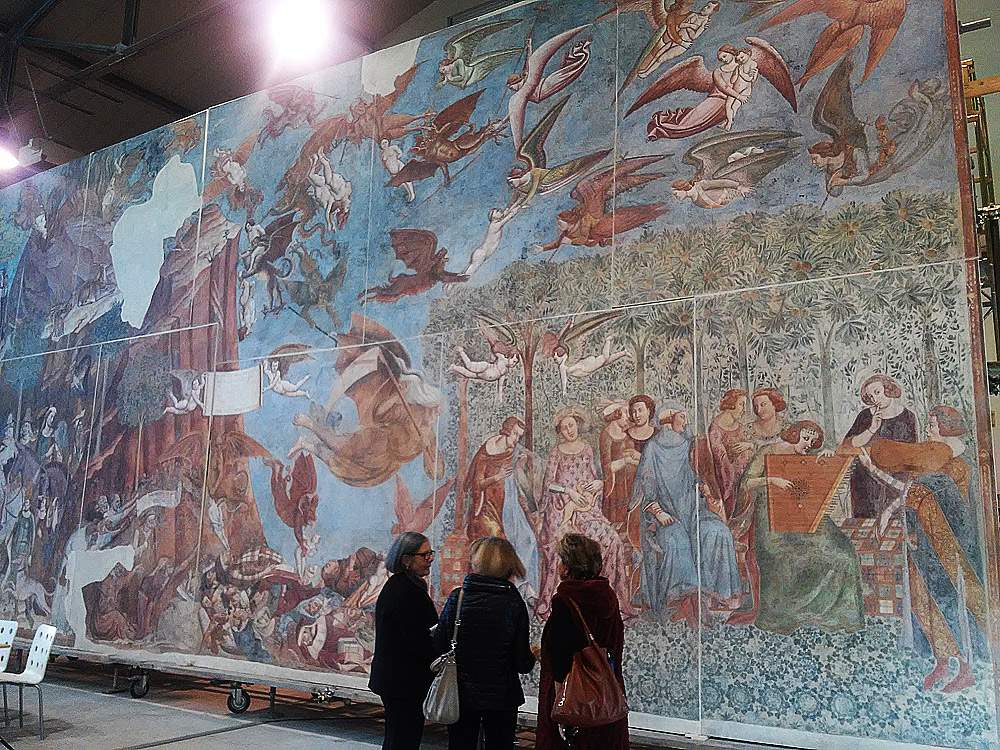by Redazione , published on 07/04/2018
Categories: Art and artists
/ Disclaimer
Presented in Pisa, in the workshops of the Opera della Primaziale Pisana, is the restoration of Buonamico Buffalmacco's spectacular Triumph of Death, the 1336-1341 fresco damaged during World War II by Allied bombing.
The restoration of Buonamico Buffalmacco’s Triumph of Death, the spectacular fresco painted between 1336 and 1341 for the Monumental Cemetery in Piazza dei Miracoli in Pisa, was presented this morning at the restoration laboratories of theOpera della Primaziale Pisana. The long restoration project of the pictorial cycle that adorns the walls of the Cemetery and in which some of the greatest artists of the 14th and 15th centuries in Tuscany participated, from Taddeo Gaddi to Spinello Aretino, from Francesco Traini to Benozzo Gozzoli, has thus come to a conclusion. An operation that has been going on since the end of World War II, when an allied bombing caused serious damage that involved the precious cycle of frescoes and necessitated a restoration that has lasted until the present day: the Triumph of Death was the missing “piece”.
It is a work of great impact, mindful of the visions of Dante’s Commedia, with death looming over all humanity, without distinction of class, position, census or age, and it offers the viewer one of the most terrible images of allmedieval art, not without, moreover, a considerable charge of social criticism that is influenced by the works of the man of letters Domenico Cavalca, a Pisan friar and writer who lived in the late 13th and early 14th centuries and was a strong scourge of worldly vanities. The attention of the percipient is also captured by the narrative vividness that leads him to follow in amazement every single detail, and by the vividness of the colors, which cause him to meditate on the theme of the precariousness of life and pain.
The interventions, carried out by the technicians of the Opera della Primaziale Pisana and, since 2009, under the control of the Works Management headed by Antonio Paolucci and under the supervision of chief restorers Carlo Giantomassi and Gianluigi Colalucci, have restored the work to its legibility, managing to repair much of the damage. A problematic work already in ancient times: there is evidence that even in the fifteenth century interventions were conducted to perform some repairs, and in the eighteenth century further restorations were carried out, necessary to stop a degradation that, otherwise, perhaps would have ended up ruining the fresco irreparably. However, it was only the restoration completed in these weeks that allowed the full recovery of the painting. The Triumph of Death will therefore be relocated to the Camposanto in June, in conjunction with the celebrations for Pisa’s patron saint, Saint Rainier.
The Works Management that took over in 2009 made a key contribution to the recovery of Buffalmacco’s cycle, which in addition to the Triumph of Death also includes the Stories of the Anchorites, the Last Judgment and theInferno. In fact, as Carlo Giantomassi explained this morning, the improved state of conservation of the cycle has imposed a rethinking of the various phases of intervention: it was therefore decided to change the detachment technique adopted until then (it involved many steps and operational phases that risked affecting the pictorial film too invasively) and also to proceed to a modification of the support, introducing new supports in vetroresima and aluminum (aerolam). Instead, an innovative system of eating bacteria, developed by microbiologist Giancarlo Ranalli of the University of Molise, was adopted for the cleaning: “trained” to eat organic material, the bacteria, applied to the surface of the painting for about three hours, allowed the removal of this material without damaging the original chromatics. Finally, the problem of condensation, related to the relocation of the work in the Camposanto, has been solved: a team composed of engineer Roberto Innocenti and Dr. Paolo Mandrioli of the CNR and engineer Giuseppe Bentivoglio of the Opera della Primaziale has designed a system of retroheating the surface of the fresco, which, following the occurrence of conditions favorable to the formation of dew, raises the surface temperature two or three degrees above the temperature of the environment, thus avoiding the formation of condensation that would risk altering the surface of the work. It is an original system operated by sensors that detect room humidity and surface temperature every ten minutes, and if conditions exceed the guard threshold, it automatically activates the back-heating system.
“I think it’s fair to say,” Antonio Paolucci commented during the presentation, “that next June 16, during the feast of the patron saint Ranieri, the last wound inflicted by World War II on Italy’s artistic heritage and not yet repaired, will be healed.” Below is a photographic selection of the Triumph of Death after restoration. In the coming days, on Finestre Sull’Arte an in-depth study dedicated to the work.
 |
| Buonamico Buffalmacco’s Triumph of Death at the presentation in the restoration workshops of the Opera della Primaziale Pisana |
 |
| The team of restorers and the Opera della Primaziale in front of Buonamico Buffalmacco’s Triumph of Death |
 |
| Buonamico Buffalmacco’s Triumph of Death at the presentation in the restoration workshops of the Opera della Primaziale Pisana |
 |
| Buonamico Buffalmacco, Triumph of Death Detail |
 |
| Buonamico Buffalmacco, Triumph of Death Detail |
 |
| Buonamico Buffalmacco, Triumph of Death Detail |
 |
| Buonamico Buffalmacco, Triumph of Death Detail |
 |
| Buonamico Buffalmacco, Triumph of Death Detail |
 |
| Triumph of Death before restoration |
 |
| Pisa, Buffalmacco's Triumph of Death performance. Restoration of the last World War II wound completed. |
Warning: the translation into English of the original Italian article was created using automatic tools.
We undertake to review all articles, but we do not guarantee the total absence of inaccuracies in the translation due to the program. You can
find the original by clicking on the ITA button. If you find any mistake,please contact us.









